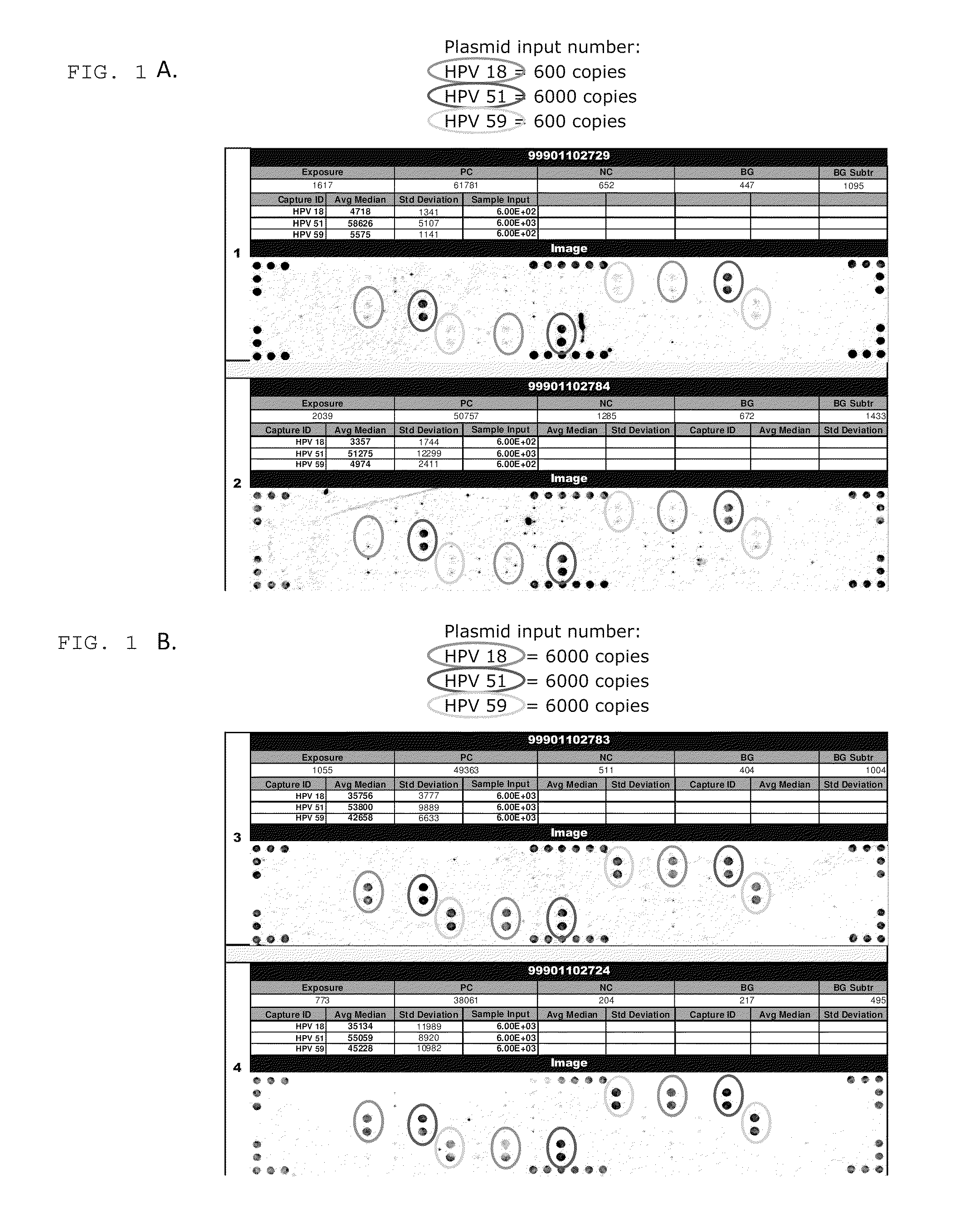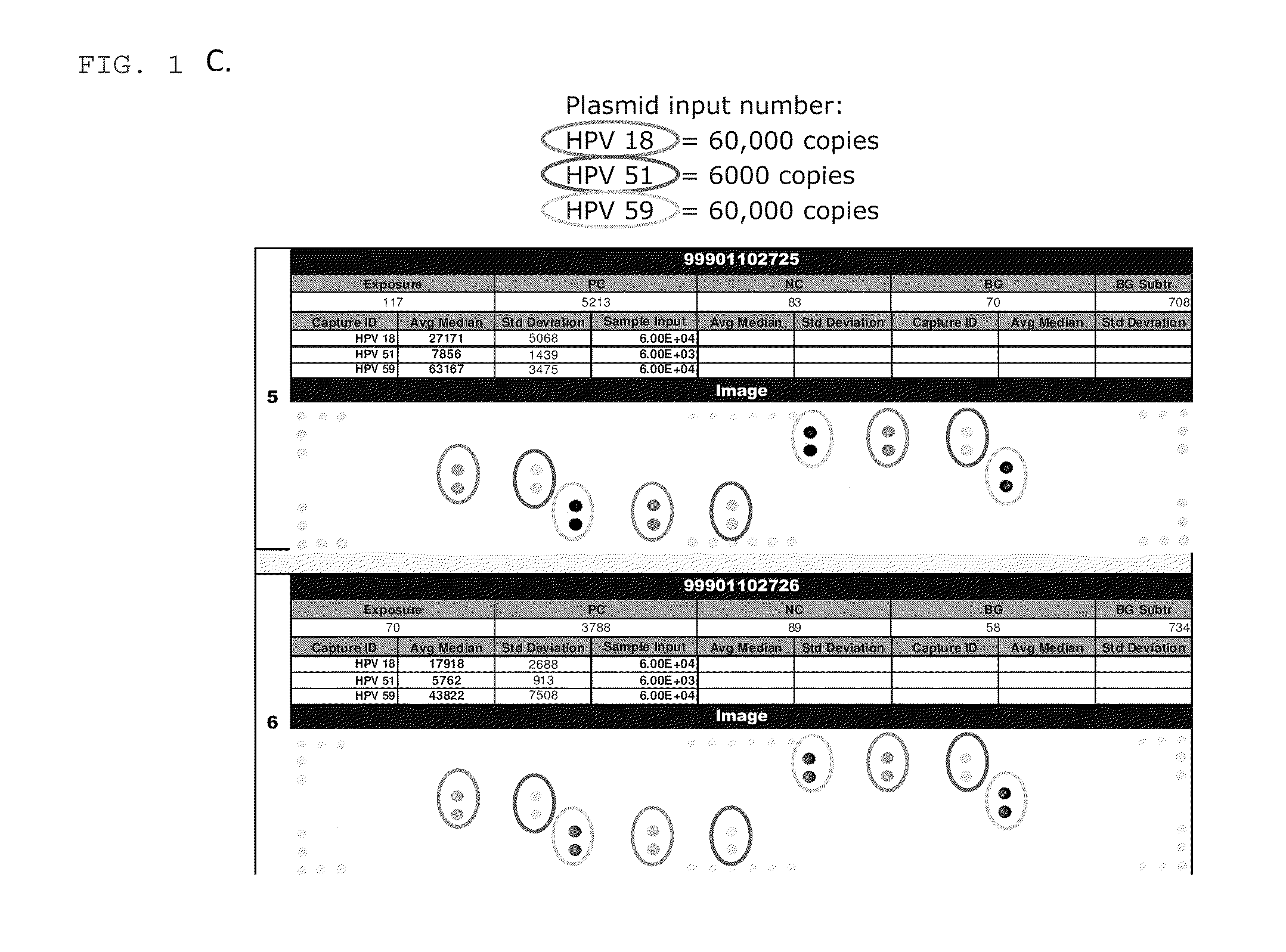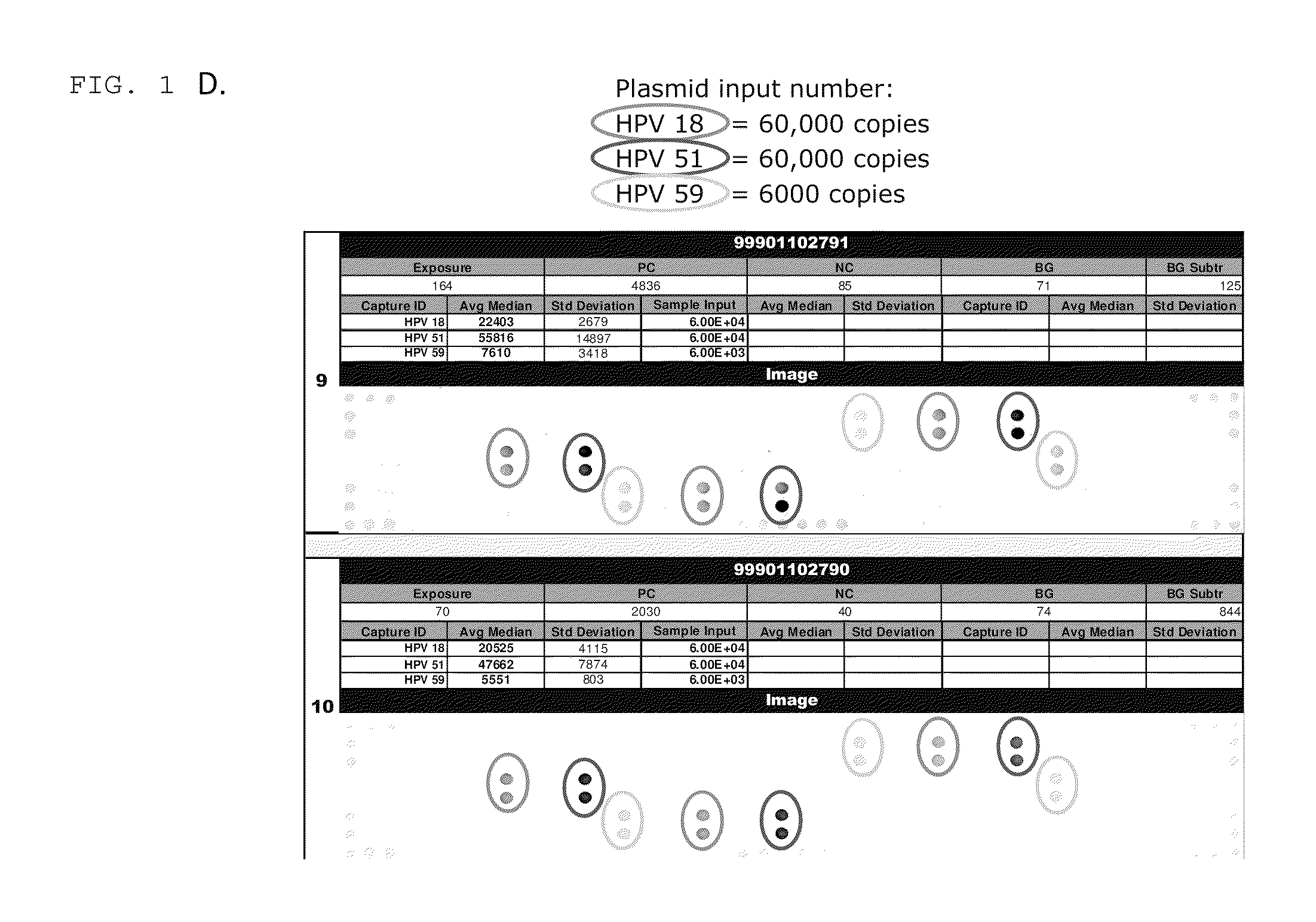[0006]In one embodiment, the invention provides a method for detecting high risk HPV in a sample. The method includes providing a substrate having a capture probe bound thereto, wherein at least a portion of the capture probe has a nucleic acid sequence that is complementary to at least a first portion of the genome of a HPV and providing a mediator probe, wherein at least a portion of the mediator probe has a nucleic acid sequence that is complementary to at least a second portion of the HPV genome that is different than the first portion and a nucleotide sequence that is complementary to a non-HPV sequence on oligonucleotides bound to a gold particle, wherein the nucleic acid sequence in the capture probe or the mediator probe, or both, are HPV-subtype specific. A sample suspected of having HPV that is optionally subjected to an amplification reaction with HPV-specific primers, is contacted with the substrate, the mediator probe and gold particles having oligonucleotides with sequences that are complementary to the nucleotide sequence in the mediator probe under conditions that are effective for the hybridization of the nucleic acid sequence in the capture probe and the nucleic acid sequence in the mediator probe to amplified HPV DNA in the sample and for the hybridization of the nucleotide sequence in the mediator probe to the oligonucleotides bound to the gold particle. The substrate is washed to remove non-specifically bound material and it is determined whether gold particles are bound to the substrate. The presence of bound particles is indicative of the presence of a specific subtype of HPV in the sample.
[0007]In one embodiment, a capture probe has about 25 to 55 nucleotides of HPV-specific sequence. In one embodiment, a capture probe includes a nucleotide sequence corresponding to one of SEQ ID No. 8-22, 38-50, 63-70, 83-94, 103-111, 119-130, 144-154, 168-175, 186-195, 207-225, 239-248, 259-264, or 276-299, a sequence with at least 80% sequence identity thereto, or the complement thereof. In one embodiment, a capture probe includes a nucleotide sequence corresponding to one of SEQ ID No. 8-22, 38-50, 63-70, 83-94, 103-111, 119-130, 144-154, 168-175, 186-195, 207-225, 239-248, 259-264, or 276-299, a sequence with at least 90% sequence identity thereto, or the complement thereof. In one embodiment, a capture probe includes a sequence corresponding one of SEQ ID No. 23-31, 51-55, 71-78, 95-98, 112-115, 131-135, 155-161, 176-181, 195-199, 226-230, 249-254, 264-267, or 300-313, or a sequence with at least 80% sequence identity thereto, or the complement thereof. In one embodiment, a capture probe includes a sequence corresponding one of SEQ ID No. 23-31, 51-55, 71-78, 95-98, 112-115, 131-135, 155-161, 176-181, 195-199, 226-230, 249-254, 264-267, or 300-313, or a sequence with at least 90% sequence identity thereto, or the complement thereof. A capture probe may include other sequences so long as they do not substantially decrease hybridization efficiency of the probe to a target HPV sequence, e.g., the other sequences are 5′ and / or 3′ to the sequences that specifically hybridize to HPV sequences, for example, the other sequence may be a tag sequence or a barcode sequence.
[0008]In one embodiment, a mediator probe has about 25 to 55 nucleotides of HPV-specific sequence. In one embodiment, a mediator probe includes a nucleotide sequence corresponding to one of SEQ ID No. 8-22, 38-50, 63-70, 83-94, 103-111, 119-130, 144-154, 168-175, 186-195, 207-225, 239-248, 259-264, or 276-299, a sequence with at least 80% sequence identity thereto, or the complement thereof. In one embodiment, a mediator probe includes a nucleotide sequence corresponding to one of SEQ ID No. 8-22, 38-50, 63-70, 83-94, 103-111, 119-130, 144-154, 168-175, 186-195, 207-225, 239-248, 259-264, or 276-299, a sequence with at least 90% sequence identity thereto, or the complement thereof. In one embodiment, a mediator probe includes a sequence corresponding one of SEQ ID No. 23-31, 51-55, 71-78, 95-98, 112-115, 131-135, 155-161, 176-181, 195-199, 226-230, 249-254, 264-267, or 300-313, a sequence with at least 80% sequence identity thereto, or the complement thereof. In one embodiment, a mediator probe includes a sequence corresponding one of SEQ ID No. 23-31, 51-55, 71-78, 95-98, 112-115, 131-135, 155-161, 176-181, 195-199, 226-230, 249-254, 264-267, or 300-313, or a sequence with at least 90% sequence identity thereto, or the complement thereof. A mediator probe also includes a sequence complementary to sequences on oligonucleotides attached to a particle, and may include other sequences so long as they do not substantially decrease hybridization efficiency of the probe to a target HPV sequence and the oligonucleotide, e.g., the other sequences 5′ and / or 3′ to the sequences that specifically hybridize to HPV sequences, for example, the other sequence may be a tag sequence or a barcode sequence.
[0009]In one embodiment, capture probes and mediator probes useful in the methods of the invention include HPV-specific sequences that do not overlap and do not cross-hybridize, e.g., do not compete for binding to the same target nucleotide sequence. In one embodiment, a selected capture and mediator probe pair hybridize to their respective target sequences under the same stringency conditions. In one embodiment, a selected capture probe and mediator probe that hybridize under different stringency conditions may be employed, e.g., the probe that hybridizes and / or remains hybridized under both hybridization conditions is hybridized to the target first. In one embodiment, a capture probe useful in the methods of the invention has sequences that hybridize to HPV sequences that are about 50 to about 2000 nucleotides apart from sequences to which the mediator probe hybridizes. n one embodiment, a capture probe useful in the methods of the invention has sequences that hybridize to HPV sequences that are about 1 to about 50 nucleotides apart from sequences to which the mediator probe hybridizes. In one embodiment, a capture probe useful in the methods of the invention has sequences that hybridize to HPV sequences that are about 500 to about 1000 nucleotides apart from sequences to which the mediator probe hybridizes.
[0010]The invention also provides a kit. For example, in one embodiment, the kit may include at least one HPV subtype-specific capture probe and optionally at least one HPV subtype-specific mediator probe, and / or DNA-P. In one embodiment the kit may include at least one subtype-specific mediator probe and optionally at least one subtype-specific capture probe, and / or DNA-P. In one embodiment, the kit includes a DNA control that may be co-amplified with a clinical sample in order to provide a clinically relevant cutoff point for detection of the HR-HPV virus. In one embodiment, the kit also includes at least one primer pair for HPV subtype-specific amplification of viral DNA in a sample.
[0011]Also provided are isolated oligonucleotides which include one of SEQ ID Nos. 1-313, a sequence with at least 80% sequence identity thereto, or the complement thereof, or a fragment thereof with at least 10, e.g., at least 15 or 20, contiguous nucleotides, of one of SEQ ID Nos. 1-313, a sequence with at least 80% sequence identity thereto, or the complement thereof. The HPV-specific sequences in the isolated oligonucleotides may be useful as primers, e.g., amplification primers, or probes.
 Login to View More
Login to View More 


